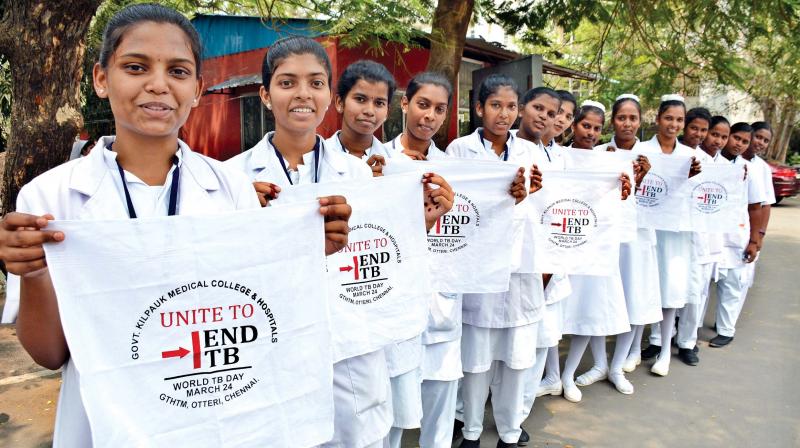Chennai: Tuberculosis remains a challenge despite available treatments
On World Tuberculosis Day, pulmonologists discuss the challenges associated with tuberculosis treatment and need of awareness on the same.

CHENNAI: With over 20 lakh cases of tuberculosis (TB) across the world, India contributes largely to the related mortality rate despite defined vaccination and medication programme.
A large number of drug-resistant TB cases have been witnessed due to late diagnosis and lack of awareness of secondary infections continues, say medicos. On World Tuberculosis Day, pulmonologists discuss the challenges associated with tuberculosis treatment and need of awareness on the same.
Though TB is caused by the contagious spread of bacteria that most affect the lungs, it can also spread to other organs. Usually, the TB bacteria affects the lungs, and if left unnoticed, it can also spread throughout the body and cause secondary infections affecting the kidneys, eyes, abdomen, brain, uterus.
The World Health Organisation (WHO), in its latest set of guidelines for combating tuberculosis, has recommended scaling up access to testing and treatment for the disease, especially among groups who are at risk, such as children and people with HIV.
Though Revised National Tuberculosis Control Programme (RNTCP) promised improved TB surveillance strategy and effective strategies to reach TB patients, the Annual TB Report 2017 showed a rise in the number of cases, with the late diagnosis being the prime reason.
In spite of specialised devices and techniques being employed in diagnosing paediatric tuberculosis, diagnosis in children is the main problem as per the annual status report of RNTCP.
The absence of appropriate samples and decentralised capacity to get appropriate samples to test for TB remains a challenge in TB detection in children.
The varied symptoms make diagnosis difficult and other invasive techniques such as Gastric Lavage, GeneXpert are difficult to be performed on small children for sample collection, say pulmonologists.
“Children cannot be diagnosed with TB through the sputum technique as they swallow it generally. We have to carry out invasive techniques to detect TB by extracting acid from the stomach through a tube. As it is a complicated technique, this cannot be performed on children mostly. This owes to the high rate of late detection of TB, mostly when it gets worse,” says Dr V. Ranjith, pulmonologist, Government TB Hospital.
The incidence of drug-resistant TB is mainly relapsed TB that usually occurs due to incomplete treatment in the first instance. Developing a resistance to drugs makes it difficult to cure over time, but TB in diabetic and HIV patients makes it complicated.
Regular medication is significant for complete treatment of tuberculosis, says consultant pulmonologist at Fortis Malar, Dr Prasanna Kumar.
Doctors also emphasise on nutrition necessary for TB patients to support the treatment they undergo. “Though prescribed drugs are primarily important, nutrition helps provide effective treatment. With malnutrition being a major problem in the country, TB patients suffering from the malnutrition need to focus on nutritional diets,”added Dr Prasanna.
Ocular TB incidence on rise
Ocular TB or tuberculosis affecting the eye has become quite common in the city with around 200 patients being diagnosed with ocular TB annually.
The biggest challenge in ocular TB is the diagnosis. Unlike the pulmonary TB, ocular TB does not manifest easily till it reaches an advanced stage. Further, the symptoms are often confusing and similar to other common eye ailments.
Some of the common symptoms are redness in the eye; ocular swelling, inflammation, etc., make it necessary to create awareness around the condition.
To overcome the epidemic, the medical fraternity, as well as the government, needs to come together and create more awareness about the disease, increase investment in research and development and technology to further augment the clinical evaluation and treatment of ocular tuberculosis.
Dr Dhivya Ashok, ophthalmologist, Dr Agarwal's Eye Hospital, said, “In a month out 20 patients that we diagnose at least one patient is diagnosed with ocular TB.
Ocular tuberculosis can manifest itself in multiple ways and if not treated at the right time it can lead to loss of vision. The condition can be caused by the bacteria spreading from the lungs to the vascular layer of the eye through the bloodstream.”
“The other common reason for ocular tuberculosis is the immune response mediator wherein the disease develops due to the low immunity in a person. This type generally occurs among people who are closely involved with TB patients for a longer duration,” she adds.

